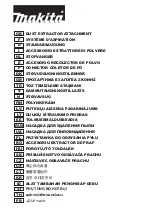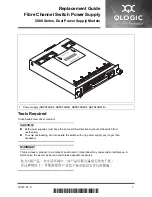
5 ENGLISH
7.
Always wear safety goggles or safety glasses with
side shield, and a full face shield when needed.
8.
Keep hands and feet away from the ejection port area.
9.
Always remove the battery cartridge before
loading the fasteners, adjustment, inspection,
maintenance or after operation is over.
10.
Make sure no one is nearby before operation.
Never attempt to drive fasteners from both the
inside and outside of wall at the same time.
Fasteners may rip through and/or fly off, pre
-
senting a grave danger.
11.
Watch your footing and maintain your balance
with the tool. Make sure there is no one below
when working in high locations.
12.
Check walls, ceilings, floors, roofing and
the like carefully to avoid possible electrical
shock, gas leakage, explosions, etc. caused by
stapling into live wires, conduits or gas pipes.
13.
Use only fasteners specified in this manual.
The use of any other fasteners may cause
malfunction of the tool.
14.
Do not tamper with the tool or attempt to use it
for other than driving fasteners.
15.
Do not operate the tool without fasteners. It
shortens the service life of the tool.
16.
Stop driving operations immediately if you
notice something wrong or out of the ordinary
with the tool.
17.
Never fasten into any materials which may
allow the fastener to puncture and fly through
as a projectile.
18.
Never actuate the switch trigger and contact ele-
ment until you are prepared to fasten workpieces.
Never defeat its purpose by securing the contact
element back or by depressing it by hand.
19.
Never tamper with the contact element. Check
the contact element frequently for proper
operations.
SAVE THESE INSTRUCTIONS.
WARNING:
DO NOT let comfort or familiarity
with product (gained from repeated use) replace
strict adherence to safety rules for the subject
product. MISUSE or failure to follow the safety
rules stated in this instruction manual may cause
serious personal injury.
Important safety instructions for
battery cartridge
1.
Before using battery cartridge, read all instruc-
tions and cautionary markings on (1) battery char-
ger, (2) battery, and (3) product using battery.
2.
Do not disassemble or tamper the battery
cartridge.
It may result in a fire, excessive heat,
or explosion.
3.
If operating time has become excessively
shorter, stop operating immediately. It may
result in a risk of overheating, possible burns
and even an explosion.
4.
If electrolyte gets into your eyes, rinse them
out with clear water and seek medical atten-
tion right away. It may result in loss of your
eyesight.
5.
Do not short the battery cartridge:
(1)
Do not touch the terminals with any con-
ductive material.
(2)
Avoid storing battery cartridge in a con-
tainer with other metal objects such as
nails, coins, etc.
(3)
Do not expose battery cartridge to water
or rain.
A battery short can cause a large current flow, over
-
heating, possible burns and even a breakdown.
6.
Do not store and use the tool and battery car-
tridge in locations where the temperature may
reach or exceed 50 °C (122 °F).
7.
Do not incinerate the battery cartridge even if
it is severely damaged or is completely worn
out. The battery cartridge can explode in a fire.
8.
Do not nail, cut, crush, throw, drop the battery cartridge,
or hit against a hard object to the battery cartridge.
Such
conduct may result in a fire, excessive heat, or explosion.
9.
Do not use a damaged battery.
10.
The contained lithium-ion batteries are subject to
the Dangerous Goods Legislation requirements.
For commercial transports e.g. by third parties,
forwarding agents, special requirement on pack-
aging and labeling must be observed.
For preparation of the item being shipped, consulting an
expert for hazardous material is required. Please also
observe possibly more detailed national regulations.
Tape or mask off open contacts and pack up the
battery in such a manner that it cannot move
around in the packaging.
11.
When disposing the battery cartridge, remove
it from the tool and dispose of it in a safe
place. Follow your local regulations relating to
disposal of battery.
12.
Use the batteries only with the products
specified by Makita.
Installing the batteries to
non-compliant products may result in a fire, exces
-
sive heat, explosion, or leak of electrolyte.
13.
If the tool is not used for a long period of time,
the battery must be removed from the tool.
14.
During and after use, the battery cartridge may
take on heat which can cause burns or low
temperature burns. Pay attention to the han-
dling of hot battery cartridges.
15.
Do not touch the terminal of the tool immediately
after use as it may get hot enough to cause burns.
16.
Do not allow chips, dust, or soil stuck into the
terminals, holes, and grooves of the battery
cartridge.
It may result in poor performance or
breakdown of the tool or battery cartridge.
17.
Unless the tool supports the use near
high-voltage electrical power lines, do not use
the battery cartridge near a high-voltage elec-
trical power lines.
It may result in a malfunction
or breakdown of the tool or battery cartridge.
SAVE THESE INSTRUCTIONS.
CAUTION:
Only use genuine Makita batteries.
Use of non-genuine Makita batteries, or batteries that
have been altered, may result in the battery bursting
causing fires, personal injury and damage. It will
also void the Makita warranty for the Makita tool and
charger.






























